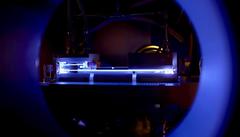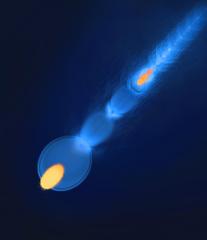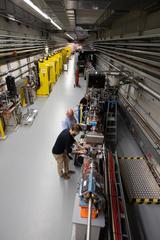URL: https://www.desy.de/news/news_search/index_eng.html
Breadcrumb Navigation
DESY News: Plasma accelerators recover in a FLASH
News
News from the DESY research centre
Plasma accelerators recover in a FLASH
An international team of researchers led by DESY scientists has demonstrated for the first time at the FLASHForward experiment that in principle it is possible to operate plasma accelerators at the repetition rates desired by particle physicists and photon scientists. This opens the opportunity to utilise such high-gradient accelerators as booster stages in existing high-repetition-rate facilities, such as the large-scale X-ray free-electron lasers FLASH and European XFEL, in order to significantly increase the energy of long trains of particles in short distances. The team presents the results of their studies in the journal Nature today.

The two FLASHForward plasma cells observed through a vacuum window. The cells are filled with argon gas and then ionised with a high-voltage electrical discharge to form a plasma. As the plasma recombines it emits light in the blue wavelength range. Both plasma cells, of length 50 and 195 millimetres, can then be used for plasma acceleration of electron bunches in gigavolt-per-metre accelerating gradients. Photo: DESY, C.A. Lindstrøm
Modern accelerators for cutting-edge science must also meet high requirements in terms of efficiency, beam quality, and number of bunches accelerated per second. In order to generate a particularly large number of light flashes or particle collisions in the shortest possible time, thousands or even millions of densely packed particle bunches must be propelled through accelerators in a single second. Plasma accelerators would, therefore, have to achieve a similar repetition rate in order to be competitive with state-of-the-art particle-accelerator technology. Current test facilities for plasma acceleration are usually operated at much slower repetition rates in the range of one to ten accelerations per second. The team led by DESY researcher Jens Osterhoff has now proven that much higher rates are possible. “At FLASHForward we were able to show for the first time that, in principle, repetition rates in the megahertz range are supported by the plasma acceleration processes”, says Osterhoff.

Graphical illustration of a probe-bunch pair sampling a plasma perturbed by the leading bunch: The novel diagnostic technique developed to enable this result relies on a pair of electron bunches (top right) interacting with the plasma perturbed by the leading bunch (bottom left). The recovery time of the plasma is defined as the separation between these two bunches at which the properties of the trailing electron-bunch pair after interaction with the perturbed plasma are identical to those without the presence of the leading bunch. Image: DESY, M. Lindstrøm, Mortani Design and Illustration

View along the FLASHForward beamline (right in the picture). It is located next to the second undulator line of the free-electron laser FLASH. The FLASHForward beamline is used to transport the electron bunches from the FLASH linear accelerator to the FLASHForward interaction area for interaction with plasma. The beaming consists primarily of magnets, such as quadrupoles for maintaining the ultra-small bunch sizes during transport and dipoles for bending the bunches onto desired trajectories. Photo: DESY, Dirk Nölle
The current findings,which involved scientists from DESY, University College London, and the Universities of Oxford and Hamburg, open the door for equipping today´s particle accelerators, which are operated at repetition rates in the kilohertz-to-megahertz regime, with plasma accelerator modules acting as booster stages to significantly increase the particle energy over the shortest distance. “The findings have a profound impact on the potential for implementation of the plasma technology towards future high repetition rate facilities for which DESY is world renowned”, concludes Wim Leemans, Director of the Accelerator Division at DESY.
Further information
Commentary of co-researcher Brian Foster (Univ. of Oxford) on the findings
Press Release of University College London
Reference
Recovery time of a plasma-wakefield accelerator; R. D’Arcy, J. Chappell, J. Beinortaite, S. Diederichs, G. Boyle, B. Foster, M.J. Garland, P. Gonzalez Caminal, C.A. Lindstrøm, G. Loisch, S. Schreiber, S. Schröder, R.J. Shalloo, M. Thévenet, S. Wesch, M. Wing, and J. Osterhoff; „Nature“, 2022; DOI: 10.1038/s41586-021-04348-8



